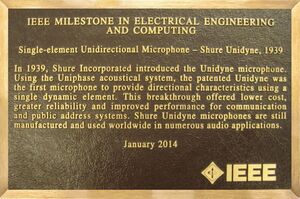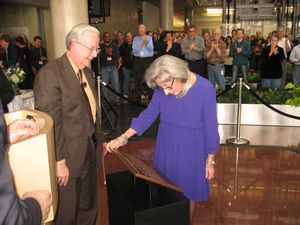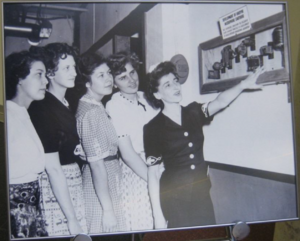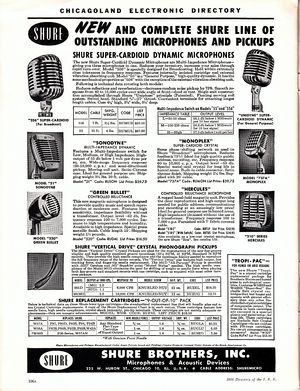Milestones:Single-element Unidirectional Microphone - Shure Unidyne, 1939
Title
Single-element Unidirectional Microphone - Shure Unidyne, 1939
Citation
In 1939, Shure Incorporated introduced the Unidyne microphone. Using the Uniphase acoustical system, the patented Unidyne was the first microphone to provide directional characteristics using a single dynamic element. This breakthrough offered lower cost, greater reliability and improved performance for communication and public address systems. Shure Unidyne microphones are still manufactured and used worldwide in numerous audio applications.
Street address(es) and GPS coordinates of the Milestone Plaque Sites
5800 W. Touhy Ave. Niles, IL 60714 US, (GPS: 42.012575, -87.772663)
Details of the physical location of the plaque
In the lobby of SHURE, Inc.'s headquarters, near a display of historical microphones and documents.
How the plaque site is protected/secured
Lobby is accessible during normal business hours, and secured otherwise.
Historical significance of the work
2013 marks the 75th anniversary of Ben Bauer’s invention of the Uniphase principle while working for Shure Brothers Incorporated, a microphone manufacturer in Chicago. As a newly graduated engineer, the 25 year-old Bauer developed an acoustical method that produced a directional microphone using only one microphone element. The Uniphase principle paved the way to the design of the Shure Unidyne microphone. Introduced in 1939, the Shure Unidyne is arguably the most recognized microphone in the world.
Benjamin Bauer (originally Baumzweiger) was born in Odessa Russia in 1913. His family fled Russia after the 1917 revolution and relocated to Cuba. At the age of 17, and speaking little English, Bauer moved to New York City to attend the Pratt Institute. After obtaining an associate Industrial Engineering degree, Bauer matriculated at the University of Cincinnati pursuing an Electrical Engineering degree. Bauer chose a five year work/study program and began working as an intern for Shure. When he graduated in 1937, he joined Shure full time as a transducer development engineer. It was the start of a distinguished career in acoustics and audio that included over one hundred patents. Benjamin B. Bauer became an IEEE Fellow member in 1952 and received his recognition on the Citation:
Features that set this work apart from similar achievements
The Unidyne microphone was the first directional microphone that used a single dynamic mic element. Using a single element reduced the size, weight, and manufactured cost, increased reliability, and significantly improved the acoustical performance. The Unidyne spawned even more popular models. The Unidyne II, a smaller version of the Unidyne, was introduced in 1951. The Unidyne III, grandchild of the Unidyne, was introduced in 1959. It is the most widely used professional microphone in the world and has been the microphone of choice for every U.S. President since Lyndon Johnson. And in 2013, a Unidyne III microphone is used on the International Space Station for live TV and Internet interviews with the crew.
Significant references
To fully understand the design details of the unidirectional microphone, you only need to read patent 2,237,298 which was filed by Benjamin Baumzweiger on September 29, 1938 and granted on April 8, 1941. To those in the sound industry, he authored the article “A New Unidirectional Microphone” in the February, 1939 issue of Electronics. Just before the IRE merger with the IEEE he contributed an article entitled “A Century of Microphones” to a commemorative issue of Proceedings of the IRE in May, 1962. However, the best endorsements about the significance of unidirectional microphone come from the sound industry. In the second edition of The Microphone Handbook by Jon Eargle (2012), the author says on page 350 in regard to Shure’s unidirectional microphone that “the M-55 has been in the Shure catalog in one form or another since its inception in the late 1930s. It is truly one of the icons of the industry and has been documented in press and news activities over the years.” In the Twelve Microphones that Made History by Jim Webb, (http://www.coutant.org/12mics/) the author says this about the Shure Unidyne Model 55. “It is hard to imagine another microphone based on its original concept and styling that has remained in production as long as some version of the Unidyne.” The invention of the single-element unidirectional microphone is truly a milestone.
Supporting materials
The following references were submitted in pdf format: Bauer-Century of Mics AES, A Century of Microphones, J. Audio Eng. Soc., Vol. 35, No. 4, 1987 April Electronics Feb 1939 Article, A New Unidirectional Microphone, Electronics, February 1939 Patent 2237298(A1), Conversion of Wave Motion Into Electrical Energy, Patent 2,237,298, April 8, 1941 The Microphone Book, The Microphone Book Second Edition, John Eargle, Focal Press Bauer Tribute-1, Bauer Obit by Cyril M. Harris, National Academy of Engineering, Volume 2 (1984) p.1 Bauer Tribute-2, Bauer Obit by Cyril M. Harris, National Academy of Engineering, Volume 2 (1984) p.2 Bauer Tribute-3, Bauer Obit by Cyril M. Harris, National Academy of Engineering, Volume 2 (1984) p.3 The following reference was submitted in jpg format: Shure Ad in 1950, Shure Advertisement, 1950 Directory of the I. R. E. Chicago Section
- Media:Bauer-Century_of_Mics_AES.pdf
- Media:Electronics_Feb_1939_Article.pdf
- Media:Patent_2237298(A1).pdf
- Media:The_Microphone_Book.pdf
- Media:Bauer_Tribute-1.pdf
- Media:Bauer Tribute-2.pdf
- Media:Bauer_Tribute-3.pdf
Map




